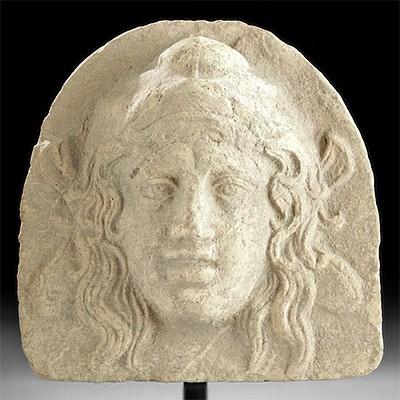Roman Marbled Glass Flask w/ Great Iridescence
Lot 62
About Seller
Artemis Gallery
686 S Taylor Ave, Ste 106
Louisville, CO 80027
United States
Selling antiquities, ancient and ethnographic art online since 1993, Artemis Gallery specializes in Classical Antiquities (Egyptian, Greek, Roman, Near Eastern), Asian, Pre-Columbian, African / Tribal / Oceanographic art. Our extensive inventory includes pottery, stone, metal, wood, glass and textil...Read more
Categories
Estimate:
$1,000 - $1,500
Absentee vs Live bid
Two ways to bid:
- Leave a max absentee bid and the platform will bid on your behalf up to your maximum bid during the live auction.
- Bid live during the auction and your bids will be submitted real-time to the auctioneer.
Bid Increments
| Price | Bid Increment |
|---|---|
| $0 | $25 |
| $300 | $50 |
| $1,000 | $100 |
| $2,000 | $250 |
| $5,000 | $500 |
| $10,000 | $1,000 |
| $20,000 | $2,500 |
| $50,000 | $5,000 |
| $100,000 | $10,000 |
| $200,000 | $20,000 |
About Auction
By Artemis Gallery
Feb 27, 2020
Set Reminder
2020-02-27 10:00:00
2020-02-27 10:00:00
America/New_York
Bidsquare
Bidsquare : VARIETY SALE | Antiquities & Ethnographic Art
https://www.bidsquare.com/auctions/artemis-gallery/variety-sale-antiquities-ethnographic-art-4920
Around the world & back in time - be amazed at the treasures you will find. Antiquities from Egypt, Greece, Italy and the Near East, Asian, Pre-Columbian, African / Tribal / Oceanic, Native American, Spanish Colonial, Russian Icons, Fine Art, much more! Artemis Gallery info@artemisgallery.com
Around the world & back in time - be amazed at the treasures you will find. Antiquities from Egypt, Greece, Italy and the Near East, Asian, Pre-Columbian, African / Tribal / Oceanic, Native American, Spanish Colonial, Russian Icons, Fine Art, much more! Artemis Gallery info@artemisgallery.com
- Lot Description
Roman, early Imperial Period, ca. 1st century CE. A gorgeous, near-opaque flask made from vertically-arranged canes of yellow, yellow-green, and blue glass flowing throughout the drop-shaped body, tubular neck, and splayed rim. This type of ancient glass - known as "marbled," "color-band," or "mosaic" glass - is created through a process of casting and blowing which allows the artist to weave strands of different-colored glass throughout the composition. The slightly concave base and smooth pontil scar allow the vessel to rest upright. A lightly-indented neck gives the flask an elegant presentation, and wonderful iridescence in silver and rainbow hues provide a burst of color. Vessels like this example were used to contain scented oils or other precious liquids by the ancient Romans. Size: 1.375" W x 3" H (3.5 cm x 7.6 cm).
For a stylistically-similar example, please see "Solid Liquid: Greek, Roman, Byzantine and Islamic Glass." Fortuna Fine Arts, Ltd., New York, 1999, p. 54, fig. 75.
Provenance: ex-Martin Wunsch collection, New York, New York, USA, acquired in the 1980s
All items legal to buy/sell under U.S. Statute covering cultural patrimony Code 2600, CHAPTER 14, and are guaranteed to be as described or your money back.
A Certificate of Authenticity will accompany all winning bids.
We ship worldwide and handle all shipping in-house for your convenience.
#142193Repaired from several pieces with some small areas of restoration along the body and base. Minor nicks and abrasions to rim, neck, body, and base, and light weathering film. Light earthen deposits and fabulous silver and rainbow iridescence throughout.Condition
- Shipping Info
-
All shipping is handled in-house for your convenience. Your invoice from Artemis Gallery will include shipping calculation instructions. If in doubt, please inquire BEFORE bidding for estimated shipping costs for individual items.
-
- Buyer's Premium



 EUR
EUR CAD
CAD AUD
AUD GBP
GBP MXN
MXN HKD
HKD CNY
CNY MYR
MYR SEK
SEK SGD
SGD CHF
CHF THB
THB
















